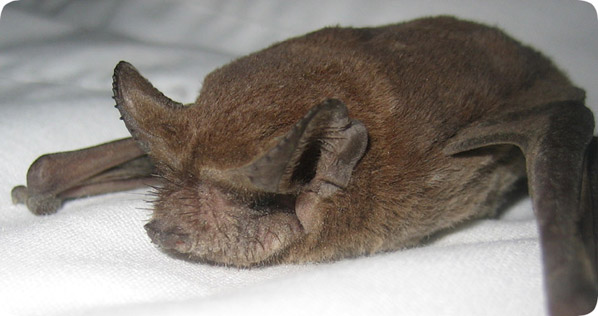|
|
|
|
|
Colonizing Bats of Florida
Brazilian Free-Tail and Evening Bat

This is a closeup photo that I took of a Brazilian Freetail Bat (Tadarida brasiliensis).

This is a closeup photo that I took of an Evening Bat (Nycticeius humeralis).
These two bats are the most common colonizing bats in the state of Florida. If you have bats living in your building, it's going to be either of these two species. I'd say that the Free-Tails make up about
80% of cases, and Evening Bats 20%, and sometimes the colonies are a mix of the two, especially for very large groups. I usually don't take possession of bats. I usually exclude them from buildings without
touching them at all, or causing them any harm. However, in the case of each of the above two photos, I had to remove bats that were stuck inside of homes. Thus, I had to physically (gently) remove them, and
thus I was able to get close-up photographs.
I'll repeat the info I have on my main bat page: The Brazilian Free Tail (Tadarida brasiliensis) is a fairly small bat - dark brown body is about 3.5 inches, wingspan about 8 inches, weight about 15 grams.
They have strange and broad ears that wrap over the brow ridge, and bristles all over their face. They aren't very attractive, in my opinion. The most noticeable physical feature of the free-tail bat, to a novice, is
the presence of the free-hanging tail, which is a little under an inch long (it can't be seen in the above photo). In most bats, the hind membrane encompasses any tail. This particular bat is one of the most numerous
mammal in the world, and some of the maternity colonies, such as in caves, are huge: comprised of
several million members. The female Free-Tail
bat gives birth to one young in early June. She nurses it for about two months, and it grows quickly. It is adult size and ready to fly by early August. These bats have a typical lifespan of 8-12 years.
The Evening Bat (Nycticeius humeralis) is fairly similar, except it is a bit larger, with a wingspan of perhaps 9-10 inches, and it is much cuter-looking, in my opinion. They live in the same types of areas as the free tails,
and often the two species will roost together. They are less common than the free-tail bats. The most important thing for me to know is that the mothers give birth much earlier, in mid-April here in FL. So I can't do any bat
exclusions in April, May, or June when Evening Bats are present.
The preferred maternity roosting areas for such bats appears to be buildings, at least in my experience. There's some huge colonies in caves here and there, but I don't know what other natural structure is really
suitable for them. Sure, sure, old dead trees, but every animal competes for those, and I've never seen bats colonizing in a tree. People say that these bats are threatened, and because such a high number can live in a
single place, it is important to protect the bats in those areas, but overall, I wonder if human buildings have actually increased the bat population. After all, they seem to love Florida's Spanish barrel tile roofs!

|
 |
© 2018 OrlandoRats.com - site content, photos, & maintenance by Orlando Rats, and Wild Animal Control |
 |
|
|